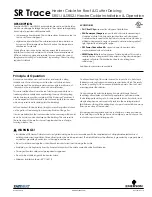
www.easyheat.com
TYPICAL MEMBRANE ROOF
Ice dams may occur on flat roofs typically at the edge of the flashing and at drains. Flat roofs are normally pitched toward drains and these
paths can become obstructed by snow and ice. To maintain a path for melt water to run off, install the heating cable as shown below using
appropriate attachment methods. Additional heating cable may be required for downspouts.
Note: Heating cable attachment methods are not shown in the diagram below. For attachment we recommend using our ZH-C roof clip.
Properly securing this clip to different roofing materials may require differing methods; consult a roofing professional for more information. If the
situation warrants it may also be possible to use strips of the roofing membrane to secure the heating cable by adhering the cable under the strip
to the main roofing membrane (see figure below).
Heating cable layout on flat roof:
• Install heating cable around the perimeter.
• Install heating cable running from the perimeter to the drain.
• Heating cable is to be installed into drain so that it extends at least 12 inches (30cm) into a heated space.
Heating cable should be positioned
around the perimeter and in the
valleys of a flat roof. The heating
cable must extend into the drain or
scupper to allow the melt water to
exit the roof.
Heating cable is to be installed into
drain so that it extends at least 12
inches (30 cm) into a heated space.
Drain
Slope
Junction
Box
Cable
End Seal
Heating cable should be
positioned around the perimeter
of a flat roof. The heating cable
must extend into the drain or
scupper to allow the melt water
to exit the roof.
Drip Loop
Cable
End Seal
Junction
Box
Scupper
Heating cable provides a continuous
heated path to allow melt water to
run off the roof before it refreezes.
Adhesive
Roof Membrane
Heating Cable
Membrane
Strip
Cable Operation
Energize cables when icing conditions are present on the roof or in gutters; de-energize when icing conditions are no longer present. Ensure
power is removed from the cable in summer.
Maintenance
Check cable annually for any damage, such as nicks or cuts possibly caused by animals or other activity on the roof. Check any ground
fault protection devices for proper operation. Remove all debris (leaves, twigs, pine needles, etc.) from roof, gutters and downspouts prior to
energizing the roof cable. Do not attempt to energize the roof cable if any of these problems are discovered as proper operation may be
impaired.























